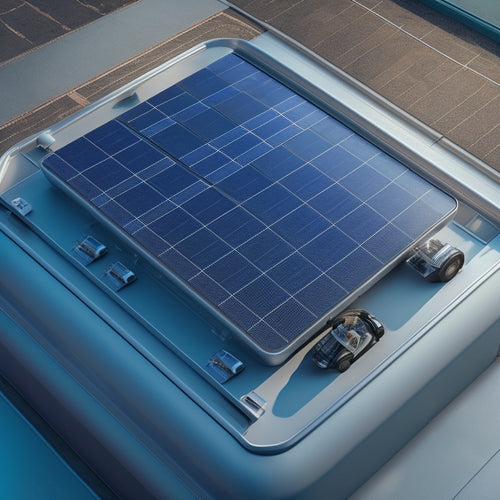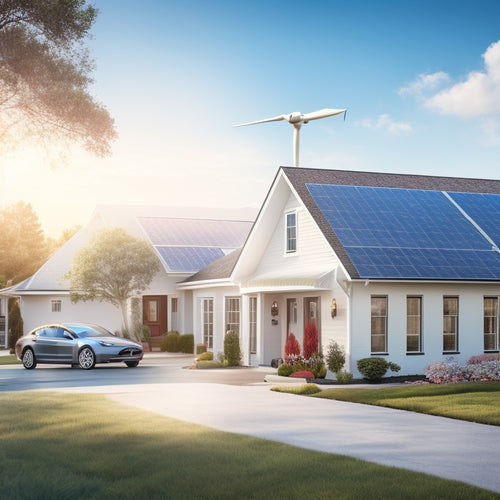
Designing and Installing Solar Power Solutions for Home
Share
You're taking the first step towards utilizing free energy from the sun by designing and installing a solar power solution for your home. Start by evaluating your home's solar potential, examining roof size, orientation, and local building codes. Then, choose the right solar panels for your needs, considering factors like efficiency, wattage, and warranty. Next, design a system that meets your energy requirements, ensuring proper sizing and component compatibility. With installation, prioritize safety and maintenance, and finally, monitor and optimize performance to maximize energy production. Now, investigate the details of each step to reveal a successful solar power solution.
Key Takeaways
- Assess your home's solar potential by evaluating solar exposure, roof size, and local building codes to determine ideal panel placement.
- Choose the right solar panels by considering efficiency, wattage, and quantity needed, as well as warranty, durability, and certifications.
- Design a solar power system that meets your energy requirements, ensuring proper system sizing and component compatibility for seamless operation.
- Ensure a safe and efficient installation by hiring qualified installers who follow proper wiring techniques and safety protocols.
- Monitor and optimize performance by tracking energy production and consumption patterns, analyzing data, and scheduling regular maintenance checks.
Assessing Your Home's Solar Potential
Determine your home's solar potential by evaluating its solar exposure, roof size, and local building codes. This site evaluation will help you understand how much energy your solar panel system can generate.
Consider the orientation of your roof, the amount of shading from trees or buildings, and the local climate. A south-facing roof with minimal shading is ideal for maximum energy production.
Next, assess your energy consumption by conducting an energy audit. Review your past utility bills to determine your average energy usage. This will help you determine the size of the solar panel system you need to meet your energy demands.
Consider energy-efficient appliances and lighting to reduce your energy consumption and maximize the benefits of your solar panel system.
A detailed site evaluation and energy audit will provide a clear understanding of your home's solar potential. This information will be essential in designing a solar panel system that meets your energy needs and maximizes your return on investment.
With an extensive assessment, you'll be well on your way to utilizing the power of solar energy for your home.
Choosing the Right Solar Panels
With a clear understanding of your home's solar potential, you can now focus on selecting the right solar panels for your system.
You'll want to evaluate panel efficiency, which measures how well a panel converts sunlight into electricity. Higher efficiency panels produce more power per hour of sunlight, making them ideal for homes with limited roof space.
When it comes to panel types, you have several options. Monocrystalline silicon panels offer high efficiency and durability, but are more expensive. Polycrystalline silicon panels are more affordable and still offer good efficiency. Thin-film panels are cheaper, but less efficient. Bifacial panels can absorb light from both the front and back, increasing energy production.
You should also assess the wattage of each panel, as well as the number of panels you'll need to meet your energy demands.
Be sure to check the warranty and durability of the panels, as well as any certifications, such as UL or IEC.
Designing a Solar Power System
Your solar panel selection is just the starting point, as now you'll need to design a solar power system that efficiently captures the energy those panels produce. The system's design is essential in maximizing energy efficiency and guaranteeing you get the most out of your investment.
To get started, you'll need to determine your energy requirements. This involves calculating your daily energy usage in watt-hours (Wh) and sizing your system accordingly. A properly sized system will assure you're generating enough power to meet your needs without over- or under-producing energy.
Some key considerations for designing an efficient solar power system include:
-
System sizing: Confirm your system is sized correctly to meet your energy demands.
-
Energy efficiency: Optimize your system's energy efficiency by selecting components with high efficiency ratings.
-
Component compatibility: Verify that all system components are compatible and work seamlessly together.
Installation and Maintenance Tips
Several vital steps await once your solar power system is designed. Now, it's time to bring your system to life. During installation, confirm your chosen installer employs proper wiring techniques to prevent electrical shock, fire hazards, and system malfunction. Verify that all electrical connections are secure, and wiring is routed away from heat sources and sharp edges.
Safety precautions are paramount during installation. Confirm your installer wears personal protective equipment, such as gloves and safety glasses, to prevent injury. Additionally, make sure the installation area is clear of debris and tripping hazards. When working at heights, always use proper fall protection equipment.
Regular maintenance is essential to optimize your system's performance and extend its lifespan. Schedule routine inspections to identify and address potential issues before they escalate. Check for loose connections, clean the panels to guarantee maximum energy absorption, and inspect the inverter for signs of malfunction.
Monitoring and Optimizing Performance
Monitoring your solar power system's performance is vital to guaranteeing it operates at its best level.
You've invested time and resources into designing and installing your solar power solution, and now it's essential to track its performance to maximize energy production and identify potential issues.
To optimize your system's performance, you'll need to:
- Track energy production and consumption patterns to identify opportunities for improvement
- Analyze data to detect any system faults or inefficiencies, allowing for swift maintenance and repair
- Monitor energy storage levels to confirm you're making the most of your excess energy and avoiding waste
Frequently Asked Questions
Can I Install Solar Panels on My Own or Should I Hire a Professional?
You're a brave navigator, charting the waters of DIY installation, but beware of hidden reefs - safety considerations lurk beneath the surface. Unless you're an expert, it's wiser to hire a professional to guarantee a smooth, safe voyage to solar power.
Will Solar Panels Increase My Property's Resale Value?
When you install solar panels, you'll enhance your property's resale value, as it's a major selling point; according to a property appraisal, solar panel benefits can increase your home's worth by up to 17%, making it more attractive to potential buyers.
How Long Does It Take to Pay off the Initial Investment?
You'll recoup your solar investment in about 7-10 years, considering the average American family saves $400-500 annually on electricity bills, making the payback period a worthwhile trade-off for long-term financial savings and a reduced carbon footprint.
Are There Any Government Incentives or Rebates for Solar Power?
You'll be thrilled to know that yes, there are government incentives for solar power; you're eligible for federal tax incentives, which can greatly reduce your system's cost, and state rebates that vary by location, further enhancing your savings.
Can I Use Solar Power to Charge My Electric Vehicle?
You can definitely use solar power to charge your electric vehicle; look for solar charging systems with EV compatibility, ensuring a seamless connection between your solar panels and your EV's charging requirements.
Related Posts
-

Top Solar Panels for Car Battery Maintenance
When selecting top solar panels for car battery maintenance, consider high-efficiency models with high wattage output...
-

Top 10 DIY Conversion Kit Reviews and Tips
You're taking the first step towards electrifying your ride, and with the right DIY conversion kit, you'll be cruisin...
-

Why Homeowners Are Embracing DIY Energy Independence
By taking control of your energy needs, you're breaking free from the uncertainty of utility bills and embracing a se...


